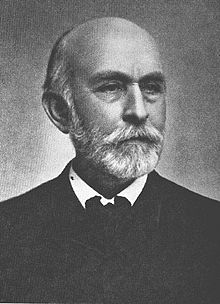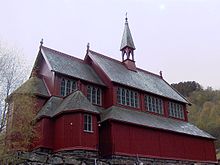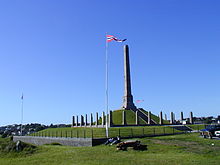Christian Christie
Eilert Christian Brodtkorb Christie (born December 24, 1832 in Bergen , † September 13, 1906 in Trondheim ) was a Norwegian architect .
Life
After his school education, he studied architecture from 1849 to 1852 at what was then the Polytechnic School of Hanover (today Gottfried Wilhelm Leibniz University of Hanover ) and from 1852 to 1854 in Karlsruhe , where he studied with the architect Friedrich Eisenlohr . In 1855 he returned to Norway and settled in Bergen , where he founded an architectural office. At the same time he had an office in Christiania (now Oslo) from 1858 to 1872 . As an architect, he was involved in the construction of various structures and in many restorations of historical buildings in Norway. For example, from 1865 to 1868 he built the new Borgund Church ( Borgund kirke ), which is located next to the old Borgund stave church , and around 1872 the Haraldsstøtten (imperial monument Haraldshaugen) in Haugesund . In the 1860s was responsible for building the State Archive (Stiftsarkivet) in Trondheim .
The growing national identity in Norway was expressed during this time through a strong interest in the preservation of cultural assets and the associated memory of the Norwegian heyday in the Middle Ages. As a result, the Norwegian Association for the Preservation of Cultural and Historical Monuments Fortidsminneforeningen commissioned Christie several times for its reconstruction projects.
As an architect, he was responsible for the planning and restoration of several medieval Norwegian buildings, including from 1873 the Håkonshalle and from 1872 the Bergen Domkirke and the Mariakirken in Bergen.
Borgund Church ( Borgund kirke ) in Lærdal , built by Christie around 1868.
Restoration of the Nidaros Cathedral .
The Riksmonumentet Haraldshaugen (Reichsmonument) Haraldshaugen .
Christian Christie's work at Nidaros Cathedral
Christie's main life's work was the restoration of Nidaros Cathedral , which he directed from 1872 until his death in 1906. He took over the construction management as master builder of the cathedral from his predecessor Heinrich Ernst Schirmer , who led the fundamental reconstruction of the Nidaros Cathedral from 1869. Schirmer had already initiated the reconstruction of the cathedral, but was criticized for his work and his artistic plans for restoration by proponents of an archaeological reconstruction. Since almost all historical templates for Nidaros Cathedral were missing, the reconstruction under Schirmer was largely based on speculation. Christie's commitment promised improvement in this respect during the reconstruction, but the cathedral was further reconstructed according to the concept of its predecessor Schirmer.
Under Christie's direction and main responsibility, the restoration of the choir, the octagon of the cathedral, the superstructure of the nave and the lower parts of the western nave were pushed ahead. He wrote some preliminary studies for the reconstruction of the Nidaros Cathedral in the Gothic style , some of which were also carried out. Christie also carefully checked the usability of the available archaeological material in order to stay closer to the historical original in contrast to its predecessor and to use these parts to reconstruct the church on a fairly solid basis. His main goal was to restore the Nidaros Cathedral to its original Gothic and Romanesque form during the reconstruction. For this reason he systematically had all newer additions removed, including the later added octagonal baroque spire of the church tower. Christie's careful and precise work on the reconstruction received wide recognition in professional circles at the time, even if by today's standards his approach is viewed as insensitive and somewhat crude.
In spite of all this, he was not spared either and was already criticized in his time because, like Schirmer, he lacked reliable sources and archaeological material for a corresponding reconstruction. Christie based the reconstruction on the theses of the French architect Eugène Viollet-le-Duc and the British Giles Gilbert Scott . These represented the principle of stylistic unity, which was already criticized at the time of Christie, because the buildings "restored" in this way could end up in a condition that they never had before. Viollet-le-Duc and his followers are now sometimes referred to as “restoration vandals”. In the case of Nidaros Cathedral, this meant the destruction of valuable architectural parts from the 16th and 17th centuries as well as from the early 1800s, which, in Christie's opinion, did not fit stylistically with the reconstruction.
Shortly after the reconstruction and completion of the main tower in 1903, there were renewed critical voices about his work as a cathedral builder. It was particularly criticized that, based on his architectural considerations, among other things, the height of the church tower was rebuilt too low and that he did not stick to archaeological evidence in the execution. According to his plans, the new, characteristic copper helmet roof was also built on the main tower of the cathedral in 1901, likewise without corresponding historical bases. Christie also developed the construction plans for the new construction of the western front of the cathedral, which were discarded after his death.
Gradually increasing criticism of his approach to the Nidaros Cathedral meant that he was dismissed as master builder in 1905. However, the debates dragged on and there was no final decision before his death. Christie was able to continue the restoration work on the cathedral until his death in 1906.
After his death, the Norwegian architects Henrik Bull and later Olaf Nordhagen were entrusted with the reconstruction.
Awards and honors
A commemorative plaque to Christian Christie was later placed in the south transept of Nidaros Cathedral after his death, to commemorate his work at Nidaros Cathedral. Furthermore, a street in Trondheim was named after Christian Christie. Christie was appointed a knight of the 1st class in 1880 , around 1895 to the commander , in 1897 to the commander with the star of the Order of Saint Olav and he was also awarded the Dannebrogorden ( knight 1st class ) and the Royal Prussian Order of the Crown .
family
Christian Christie was the son of customs officer Werner Hosewinckel Christie (1785–1872) and his wife Hansine Langsted (1802–1864). His relatives included many well-known or prominent personalities in Norway and beyond, including his brother, the well-known Norwegian lawyer and politician Hans Langsted Christie (1826-1907), his cousin , the writer Johan Koren Christie (1814-1885) Uncle, the politician Edvard Eilert Christie (1773–1831), his nephew, the constitutional lawyer Wilhelm Frimann Koren Christie (1778–1849) and his great-nephew, Major General of the Norwegian Air Force Werner Hosewinckel Christie (December 13, 1917 - December 29, 2004) .
literature
- Gerhard Fischer: Nidaros Domkirke - Gjenreisning i 100 år. Land og kirke, Oslo 1969, OCLC 462848815 .
Web links
- Christian Christie in the store norske leksikon (Norwegian)
- Biography in Norsk biografisk leksikon (Norwegian)
- Christie, Christian (3) . In: Bernhard Meijer, Theodor Westrin (ed.): Nordisk familjebok konversationslexikon och realencyklopedi . 2nd Edition. tape 5 : Cestius-Degas . Nordisk familjeboks förlag, Stockholm 1906, Sp. 255-256 (Swedish, runeberg.org ).
- Christie, Christian . In: Christian Blangstrup (Ed.): Salmonsens Konversationsleksikon . 2nd Edition. tape 4 : Bridge-Cikader . JH Schultz Forlag, Copenhagen 1916, p. 916-917 (Danish, runeberg.org ).
Individual evidence
- ^ Christian Christie (Norsk Biografisk Leksikon)
- ↑ Haraldshaugen, the national monument. (Haugesunds Avis) ( Memento of the original dated June 4, 2011 in the Internet Archive ) Info: The archive link was inserted automatically and has not yet been checked. Please check the original and archive link according to the instructions and then remove this notice. . (Norwegian)
- ^ Petter Henriksen: Christian Christie . In: Store norske leksikon . Kunnskapsforlaget , Oslo 2007 (Norwegian, online [accessed July 23, 2012]).
- ↑ Christian Christie. Architect. on: snl.no
| personal data | |
|---|---|
| SURNAME | Christie, Christian |
| ALTERNATIVE NAMES | Christie, Eilert Christian Brodtkorb (full name) |
| BRIEF DESCRIPTION | Norwegian architect |
| DATE OF BIRTH | December 24, 1832 |
| PLACE OF BIRTH | Mountains |
| DATE OF DEATH | September 13, 1906 |
| Place of death | Trondheim |





